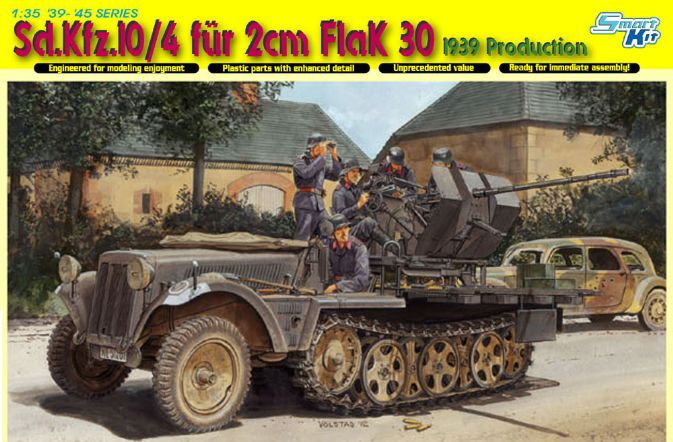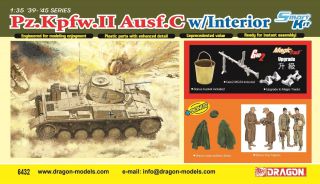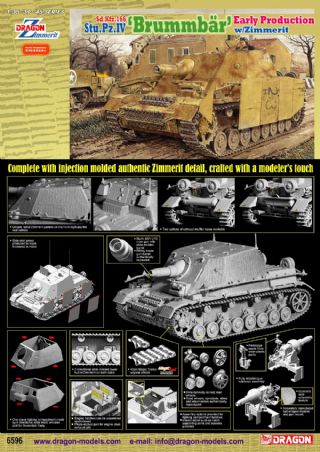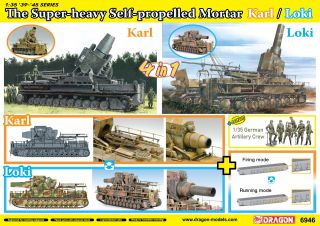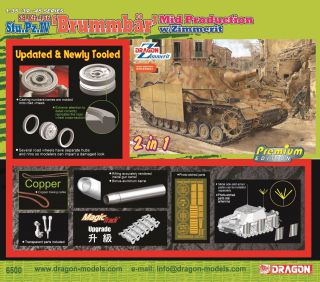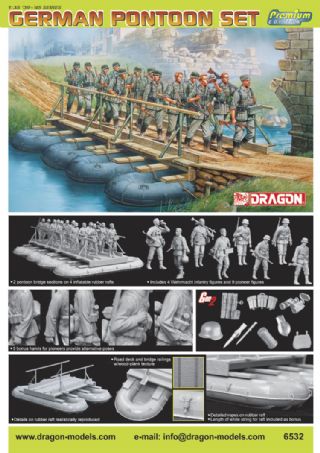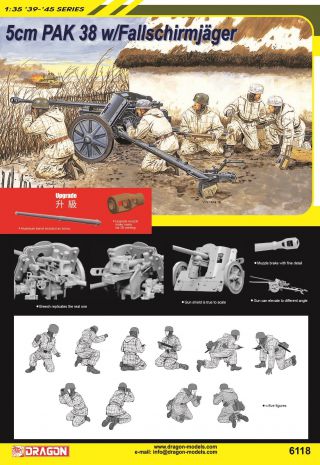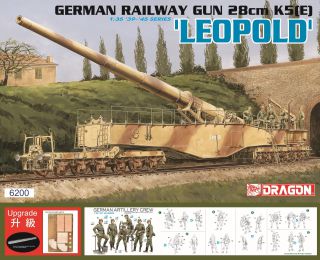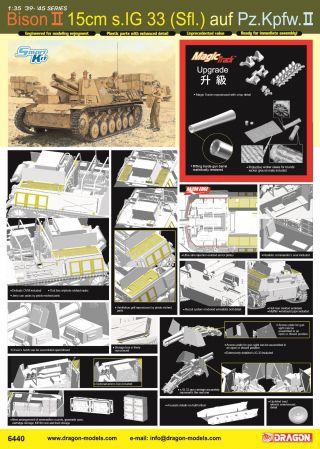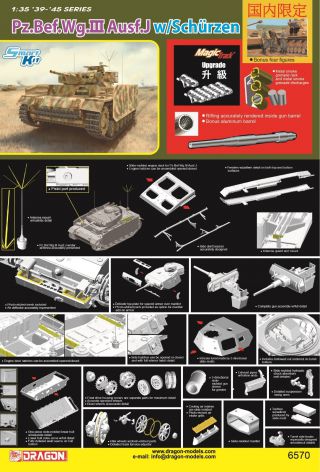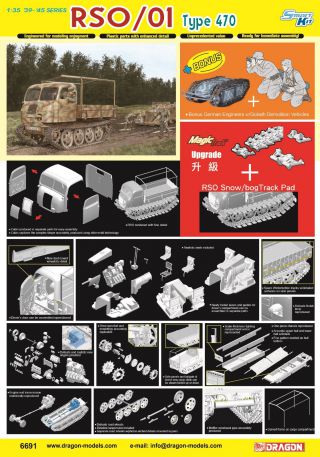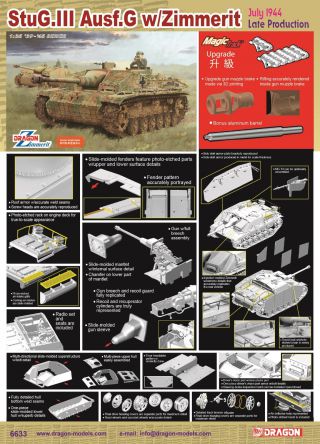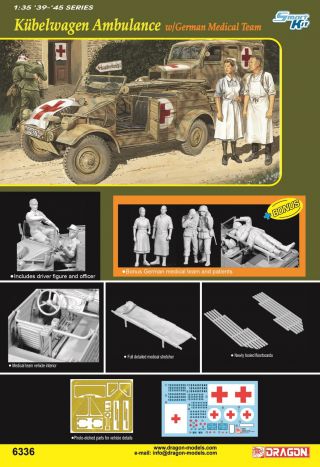HOME → Dragon Plastic Model Kits → 1/35 WWII Military → 6739
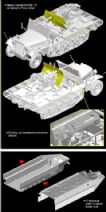


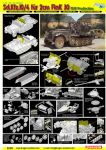
Barcode: 0 89195 86739 1
Packaging: 20 pieces per carton
Box Size: 9.6" x 15" x 2.4"
Features:
- Newly tooled Sd.Kfz.10 rendered w/fine detail
- Newly tooled photo-etched gun shield
- Driving compartment w/interior details
- One-piece slide-molded lower hull
- 2cm FlaK 30 with intricate detail
- Accurate 2cm FlaK 30 can rotate to different positions
- Gun can optionally elevate to different angles
- Gunner's seat included
- 2cm FlaK 30 cannon w/optional magazines
- Slide-molded one-piece gun barrel w/hollow muzzle
- Intricate engine housing
- Engine represented by multiple parts
- 2cm FlaK 30 assembled in travel or combat mode
- Separate parts for authentic triangular base-plate gun platform
- Intricate tread pattern molded on gun platform
- Delicate pedal w/detailed pattern
- Realistic engine hood formed from multiple parts w/open louver detail
- Delicate gearbox included
- Optional photo-etched gun sight offers great detail definition
- Gun cradle and hand wheels w/well-defined details
- Fully detailed steering components
- Suspension system as per the real vehicle
- Slide-molded suspension arms and springs w/delicate detail
- Drive sprocket w/multi-part assembly to achieve the highest levels of detail and accuracy
- Road wheels w/precise detail
- Includes clear lenses for headlamps
- Wing mirror and spotlight included
- Rear chassis w/realistic tow pintle depicted like the real one
- Magic Tracks for convenient assembly
Germany fielded a wide range of halftracks during WWII. The Sd.Kfz.10, one of the lighter types, was conceived as a prime mover for small towed guns such as the 3.7cm PaK 36. Measuring 4.5m long and weighing 4.9 tonnes, this Demag-designed vehicle had a 1-ton payload capacity. Around 14,000 Sd.Kfz.10 halftracks were built from 1938-45. Several specialist vehicles were based on this halftrack design, among them the Sd.Kfz.10/4. This type had a platform on the rear for carrying an antiaircraft 2cm FlaK 30 cannon. The purpose-built platform had fold-down sides and rear for the seven-man crew to serve and traverse the weapon 360^(o) in combat. The Sd.Kfz.10/4 was used by both the Wehrmacht and Luftwaffe, and of course it could be equally effective against ground targets.
Dragon has already produced a 1/35 scale 1-ton Sd.Kfz.10 halftrack in plastic and it was warmly received by modelers. Dragon has now expanded the family with the Sd.Kfz.10/4 by adding the company’s world-famous 2cm FlaK 30 kit. The rear platform is completely new to suit this particular vehicle type. The same is also true of the front-wheel fenders. The kit’s fully detailed, and even hidden internal components like the engine and gearbox are provided. Upgraded road wheels and Magic Tracks from the original Sd.Kfz.10 have resulted in a spectacular halftrack. Designed to hit low-flying Allied aircraft, this vehicle will also be a hit with modelers!
Reviews:
Sd.Kfz.10/4 fur 2cm FlaK 30 1939 Production
Manufacturer: Dragon Models
Scale: 1/35
Material: Styrene & Photo-etch
Serial Number: 6739
Price: TBA
Introduction
The Sd.Kfz.10 was originally designed to tow small guns such as 2cm FlaK 30
or 38 amongst others, but eventually was use to actually mount several of these
guns, sometimes with an armoured cab. Dragon/Cyber-Hobby began releasing newly
tooled versions of this vehicle a couple of years ago, this unarmoured version
mounting the FlaK 30 being their latest release.
Kit Contents
These kits are fairly deceptive, in that on opening the box, you would almost
swear there wasn't enough to make the kit. It's a little like the Magic Tracks
supplied for these ones. Once you begin building them you'll worry that you
don't have enough, all the way through to putting them on the actual model!
Obviously this is as a result of the vehicles size. It wasn't a large one!
The contents consist of a series of grey sprues, some new, some from earlier released versions, three photo-etched brass frets, a transparent sprue, two bags of 'Magic Track' individual link tracks, and a separate slide-moulded lower hull. In addition of course, there are a small decal sheet, a set of windscreen masks, and eight sides of instructions.
The chances are that most Axis modellers will feel as if they've built this one before, since the vast majority of parts are almost generic to other Dragon/Cyber-Hobby releases of the Sd.Kfz.10. If you haven't built one of them before, and fancy having a go at this one....you're in for a treat!
The quality of moulding almost goes without saying in a new Dragon release these days. Very occasionally where a new release contains a sprue from a slightly older kit to provide a necessary part, you find a slight bit of flash or some 'soft' detail...but not in this one. A couple of years ago when Dragon released their first version, everything was new from the ground up so to speak. As a result, the moulding is first class, there's absolutely no flash and the detail is pin sharp. Add to this good design a full engine, fully detailed chassis, photo-etched shields for the gun, and you can see where this is going.
Construction begins with the assembly of the running gear onto the slide moulded lower hull. Each of the roadwheel pairs is provided in two halves, with full detail on their inner surfaces of course, and the drive sprockets are provided as three-part assemblies. The two front tyred roadwheels are provided in two halves that trap a centre hub. The suspension and steering mechanism on these two front wheels is fully detailed, and care must be taken to orientate the parts the correct way or you could make problems for yourself later on. Although there's lots of detail in this area, the front wheels themselves are not steerable so point straight ahead unless you want to make some extra work for yourself! The suspension for the tracked roadwheels is torsion bar as on the real thing, and on the model too, with separate torsion bars supplied for each roadwheel pair that have to be fixed through holes on the lower hull. Unlike some other Dragon models, there are no locating blocks on the opposite inside of the lower hull, each torsion bare merely slipping into a trough moulded into the bottom of the hull, but with care and judicious use of cement, it wouldn't be too difficult to leave the suspension capable of being animated later in the build, particularly as the track supplied is of the individual link type.
Construction then moves to the engine. A full assembly is provided, which means that if you wish to leave the hood open to display it, a good paint job, especially if some small wires and cabling were to be added, would look quite impressive. Of course the transmission is included too, along with that gear lever missing from the first couple of releases. The driver's area is given a fully detailed dashboard, as you would expect, the various dials moulded completely flat so that the supplied instrument decals can be more easily applied. In addition we're given various data plates on the decal sheet for this area. This is one of those models that will involve various sub-assemblies being painted during construction; such is the level of detail provided. For example, the engine can be made as a sub-assembly, as can the driver's area, and the transmission and fuel tanks, before bringing them together to fit to the lower hull. Once they have been brought together, work can begin on fitting various body panels to cover them all up! Beginning with the radiator and housing, bracing struts for the engine compartment, we then move to the front radiator which is beautifully moulded with open slats, although little can be seen of the radiator detail if you choose to have the hood closed. The instructions do indicate at this point how the engine hood would have appeared if left opened, although no mechanism, such as a bracing strut is provided to hold them up with. There's also a small ejector pin mark on the inner surface of each that will have to be dealt with should you choose to display them opened. On the plus side, the incredibly fine ventilation louvres are moulded open on each of the panels; with absolutely no flash....they just look so good! The two front curved fenders are also installed at this point. From what I can find there appears to be a bracing strut missing from beneath these too, although with the wheels on it's almost impossible to tell.
Finishing off the front of the vehicle, the windscreen assembly is provided as a one-piece transparent part. Dragon supply paint masks for this, four, two on either side. They're actually about 1mm too small, so you'll have to use masking tape anyway. The headlights are supplied with two types of lenses, both in transparent plastic, either normal or blackout ones which can them be masked before painting. The various tools to fit to fenders etc., are of the 'Smart Series' type, i.e. they have clamps moulded in place, but with hollow hasps.
Moving to the rear of the vehicle, the framed support for the load bed always looks hellishly complicated for these since it's provided as one part with multiple moulding stubs. I do really mean multiple too. It certainly takes some cleaning up, but it well worth it, and don't forget all those lugs mean that there are no ejector pin marks to mar the surface. The floor that fits to the framework is newly moulded to mount the FlaK 30 and is devoid of tread pattern detail. That's not to say it devoid of detail though, with all the various hinged panels finely moulded onto its surface. The various mounting posts for the gun are provided as separate parts that fit into holes on the bed, which can then be mounted to the chassis. To finish off the rear bed, the side and rear gate are constructed and fitted in either a raised or lowered position. All three side gates are produced as styrene frames onto which photo-etched mesh panels are then fitted. I have to admit to having seen better mesh panels though, in that these ones are moulded curiously 'flat' looking. A saving grace is that the mesh is obscured in places by virtue of their being various ammunition boxes with their brackets being fixed along their length.
Construction them moves to the FlaK 30. This is basically the one earlier released as a stand alone kit - Cyber-Hobby 6722. Since there's no trailer of course, it's essentially all supplied on one sprue, and we're given the same sprue that was in the Cyber-Hobby kit...with a few differences. One of the main shortcomings in the Cyber-Hobby kit of the FlaK 30 was that the turntable was moulded as part of the tri-form base. This meant that the gun couldn't be rotated to a desired position. I built the kit and adapted it so that it could be, and was quite vociferous in my criticism of this. Well...they've fixed it. The turntable is now supplied as a separate part. They've omitted to mention it on the instructions though. The diagrams on the instructions have been lifted directly from that kit, meaning there's no reference whatsoever to a separate turntable. No biggie though...anybody building it will discover this fact. There are also some brand new parts 'squeezed' onto the sprue, even though it is the same sprue, they've just been machined in between existing parts. Most of these are small brackets and fittings required to fit the full set of photo-etched shields that are now supplied in this kit and were not supplied in the Cyber-Hobby kit. There are two parts however, that are supplied (A75 & A76) but not mentioned on the instructions. These are actually only required if you decide on one of the specific options for the main gun sight, that being the later and probably more common Flakvisier 30 with the box covering. Parts A75 & A76 consist of this box, and are shown fitted on the instructions, but not mentioned by number.
The reverse of the instructions show three marking schemes, all in overall panzer grey, and without any markings other than number plates, which are supplied as individual digits n the decal sheet. See below for further details.
Conclusion
The small errors and omissions in the instructions shouldn't put anybody off...
after all it's all still here, just takes a little working out! Once you have
worked it out, you'll end up with a superbly detailed and engineered model of
this diminutive German halftrack. Brilliant!
- Vinnie Branigan

